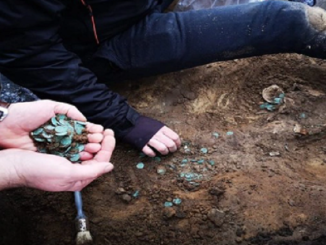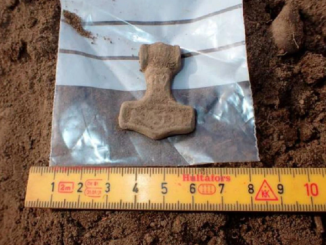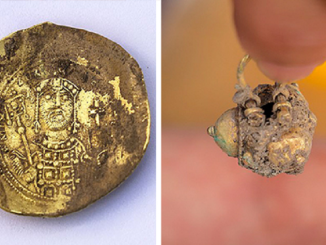Metal detectorists found an earring that may have been a gift from a Byzantine emperor to a Viking in the 11th century.

Front and back views of rare gold earrings discovered in West Jutland, Denmark. Photo: Nationalmuseet
Frants Fugl Vestergaard, a 54-year-old man from Denmark, dug up rare gold earrings while metal detecting in a field in West Jutland, the National Museum of Denmark in Copenhagen announced on December 5.
The earrings consist of a crescent-shaped piece of gold covered with enamel, with a gold frame attached with small gold beads and rings. The decoration on the gold piece depicts two stylized birds surrounding a tree, symbolizing the tree of life.
This earring most likely originated from the Middle East and is the first artifact of its kind found in Scandinavia. Researchers also said that this 1,000-year-old artifact could bring a breakthrough in learning about the Vikings and the Middle East.
Gold earrings are so rare that only 12 similar artifacts have been found in the world. This may have been a gift from a Byzantine emperor to a Viking leader in the 11th century, according to Peter Pentz, an expert at the National Museum of Denmark. However, it is also possible that the emperor gave it to a Danish Viking who was his bodyguard.
In the mid-7th century, the Danes, Norwegians and Swedes began to invade the British Isles. In the 8th century, they expanded their territory and raided the coast of Ireland, the Faroe Islands, Iceland, Greenland and Normandy, and expanded eastward along the Baltic coast. They also invaded the Dnieper and Volga trade routes in eastern Europe.
Vikings brought silver and gold coins and treasure from coastal villages, towns, and monasteries back home, but rarely jewelry, according to Pentz. This makes the earrings extremely special. Not only the origin but the reason this jewelry was buried in West Jutland is also a mystery. Pentz also said that there are no Viking archaeological sites near the site where the gold earrings were discovered.


